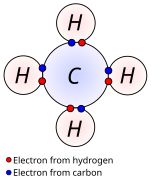Covalent bond
Covalent bonding is a form of chemical bonding that is characterized by the sharing of pairs of electrons between atoms. In short, attraction-to-repulsion stability that forms between atoms when they share electrons is known as covalent bonding. The term "covalence", in regards to bonding, was first used in 1919 by Irving Langmuir in a Journal of American Chemical Society article entitled "Isomorphism, Isosterism, and Covalence" wherein he states:[1]
I propose that the number of electrons which any given atom shares with the adjacent atoms be called the covalence of that atom.
Covalent bonding includes many kinds of interactions, including σ-bonding, π-bonding, metal-metal bonding, agostic interactions, and three-center two-electron bonds.[2][3] The term covalent bond dates from 1939.[4] The prefix co- means jointly, associated in action, partnered to a lesser degree, etc.; thus a "co-valent bond", essentially, means that the atoms share "valence", such as is discussed in valence bond theory. In the molecule H2, the hydrogen atoms share the two electrons via covalent bonding. Covalency is greatest between atoms of similar electronegativities. Thus, covalent bonding does not necessarily require the two atoms be of the same elements, only that they be of comparable electronegativity. Because covalent bonding entails sharing of electrons, is necessarily delocalized. Furthermore, in contrast to electrostatic interactions ("ionic bonds") the strength of covalent bond depends on the angular relation between atoms in polyatomic molecules.

History
The idea of covalent bonding can be traced to Gilbert N. Lewis, who in 1916 described the sharing of electron pairs between atoms. He introduced the so called Lewis notation or electron dot notation or The Lewis Dot Structure in which valence electrons (those in the outer shell) are represented as dots around the atomic symbols. Pairs of electrons located between atoms represent covalent bonds. Multiple pairs represent multiple bonds, such as double and triple bonds. Some examples of Electron Dot Notation are shown in the following figure. An alternative form, in which bond-forming electron pairs are represented as solid lines, is shown alongside.

While the idea of shared electron pairs provides an effective qualitative picture of covalent bonding, quantum mechanics is needed to understand the nature of these bonds and predict the structures and properties of simple molecules. Walter Heitler and Fritz London are credited with the first successful quantum mechanical explanation of a chemical bond, specifically that of molecular hydrogen, in 1927. Their work was based on the valence bond model, which assumes that a chemical bond is formed when there is good overlap between the atomic orbitals of participating atoms. These atomic orbitals are known to have specific angular relationships between each other, and thus the valence bond model can successfully predict the bond angles observed in simple molecules.
Bond order
Bond order is a number that indicates the number of pairs of electrons shared between atoms forming a covalent bond. The term is only applicable to diatomic molecules, but is used to describe bonds within polyatomic compounds as well.
- The most common type of covalent bond is the single bond, the sharing of only one pair of electrons between two atoms. It usually consists of one sigma bond. All bonds with more than one shared pair are called multiple bonds.
- Sharing two pairs is called a double bond. An example is in ethylene (between the carbon atoms). It usually consists of one sigma bond and one pi bond.
- Sharing three pairs is called a triple bond. An example is in hydrogen cyanide (between C and N). It usually consists of one sigma bond and two pi-bonds.
- Quadruple bonds are found in the transition metals. Molybdenum and rhenium are the elements most commonly observed with this bonding configuration. An example of a quadruple bond is also found in Di-tungsten tetra(hpp).
- Quintuple bonds have been found to exist in certain dichromium compounds.
- The only known molecules with true sextuple bonds (order 6) are diatomic Mo2 and W2, in the gaseous phase at very low temperatures. Although diatomic Cr2 and U2 have formal structures with twelve-electron bonds, their effective bond orders (derived from quantum chemistry calculations) are less than 5. There is strong evidence to believe that no two elements in the periodic table can form a bond with greater order than 6.[5]
Most bonding of course, is not localized, so the following classification, while powerful and pervasive, is of limited validity. Three center bond do not conform readily to the above conventions.
my computer is really slow
Current theory
Today the valence bond model has been supplanted by the molecular orbital model. In this model, as atoms are brought together, the atomic orbitals interact to form molecular orbitals, which are linear sums and differences of the atomic orbitals. These molecular orbitals are a cross between the original atomic orbitals and generally extend between the two bonding atoms.
Using quantum mechanics it is possible to calculate the electronic structure, energy levels, bond angles, bond distances, dipole moments, and electromagnetic spectra of simple molecules with a high degree of accuracy. Bond distances and angles can be calculated as accurately as they can be measured (distances to a few pm and bond angles to a few degrees). For small molecules, calculations are sufficiently accurate to be useful for determining thermodynamic heats of formation and kinetic activation energy barriers.
References
- ^ Langmuir, I. (1919). "Isomorphism, Isosterism and Covalence." J. Am. Chem. Soc.; 1919; 41(10); 1543-1559.
- ^ March, J. “Advanced Organic Chemistry” $th Ed. J. Wiley and Sons, 1992: New York. ISBN 0-471-60180-2.
- ^ G. L. Miessler and D. A. Tarr “Inorganic Chemistry” 3rd Ed, Pearson/Prentice Hall publisher, ISBN 0-13-035471-6.
- ^ Merriam-Webster - Collegiate Dictionary (2000).
- ^ Roos, Björn O. (2007). "Reaching the Maximum Multiplicity of the Covalent Chemical Bond". Angewandte Chemie International Edition. doi:10.1002/anie.200603600.
{{cite journal}}: Unknown parameter|coauthors=ignored (|author=suggested) (help); Unknown parameter|month=ignored (help)
- http://www.chemguide.co.uk/atoms/bonding/covalent.html
- http://www.chem.ox.ac.uk/vrchemistry/electronsandbonds/intro1.htm
- http://hyperphysics.phy-astr.gsu.edu/hbase/chemical/bond.html#c5
